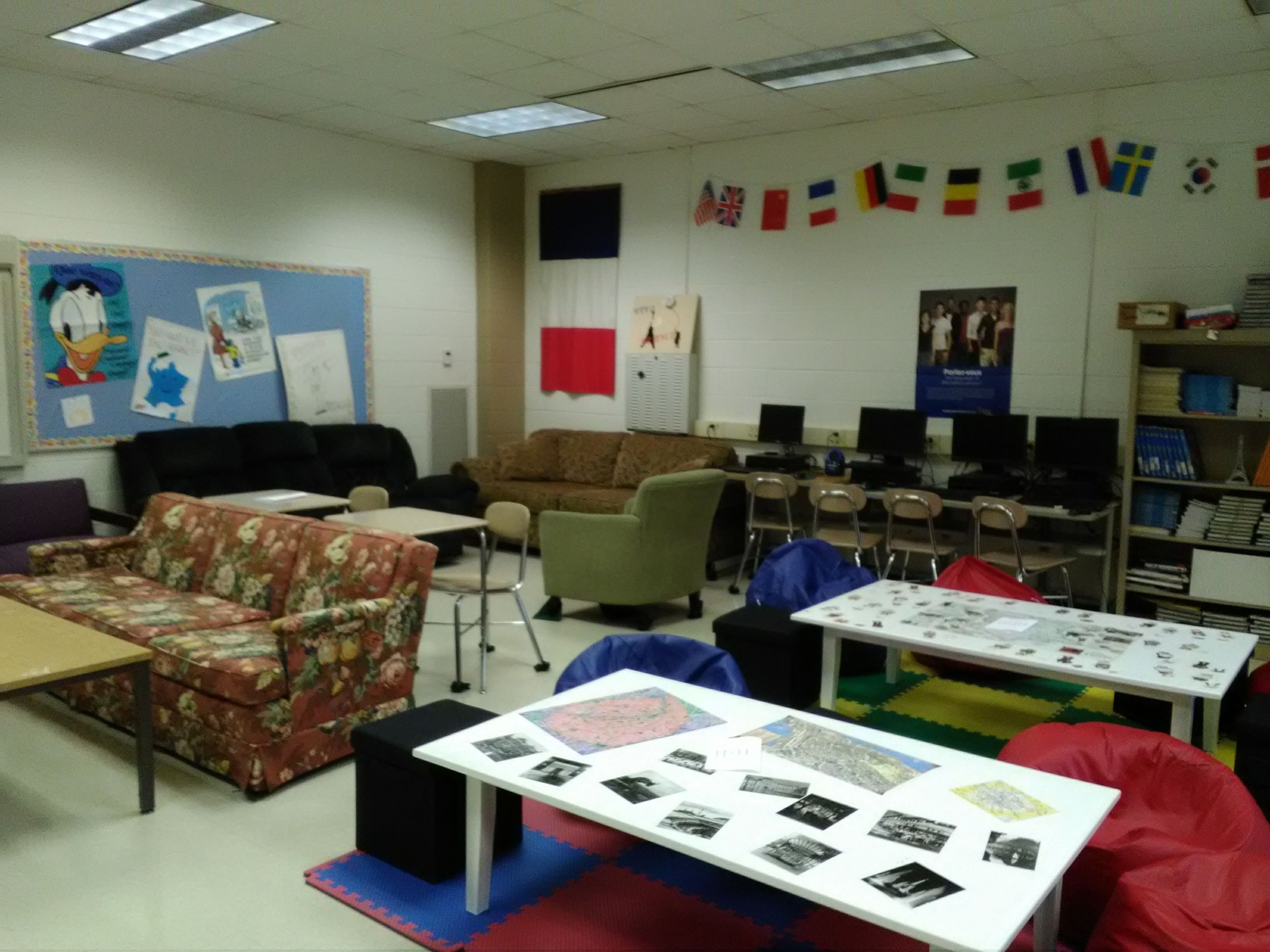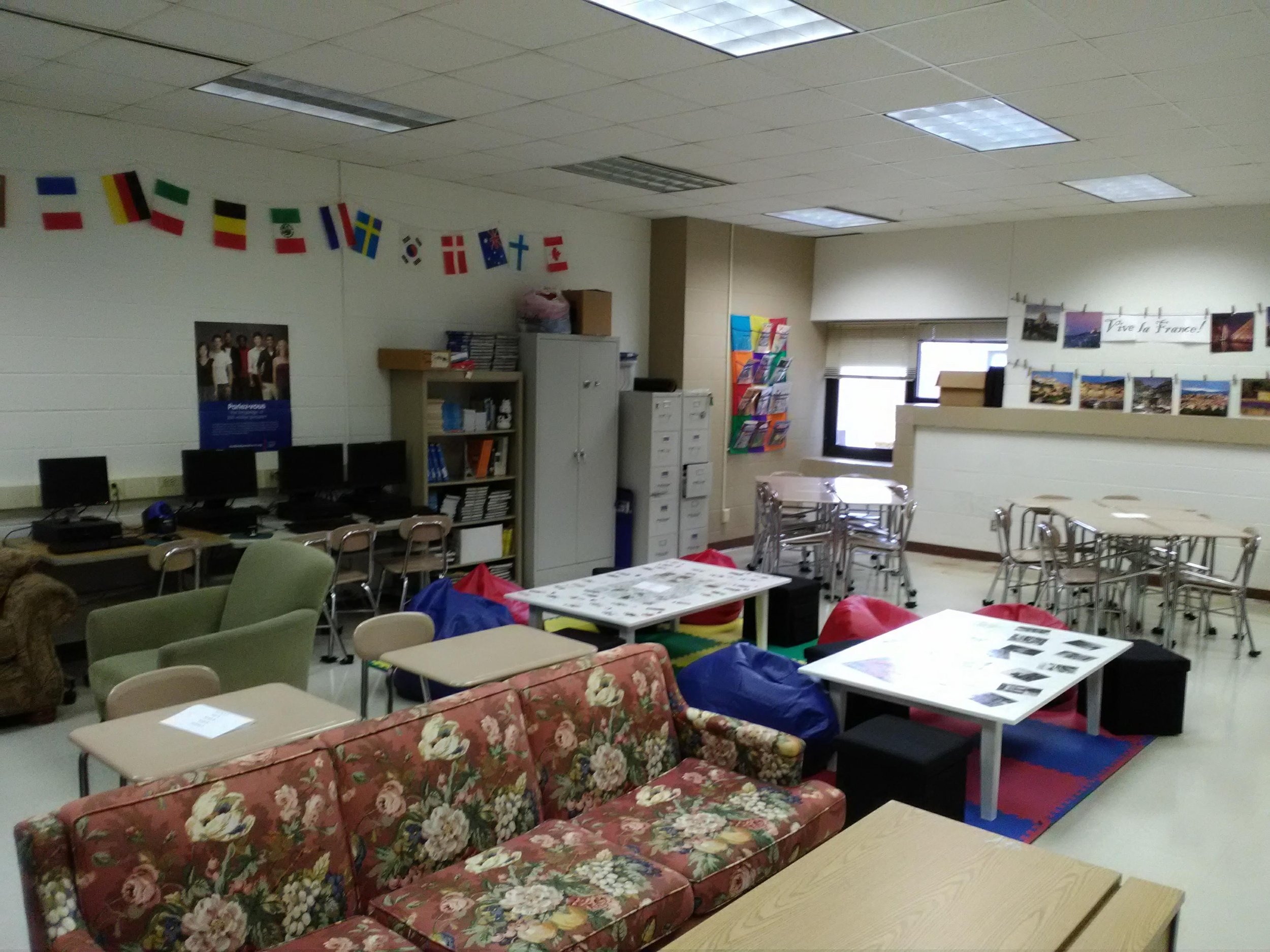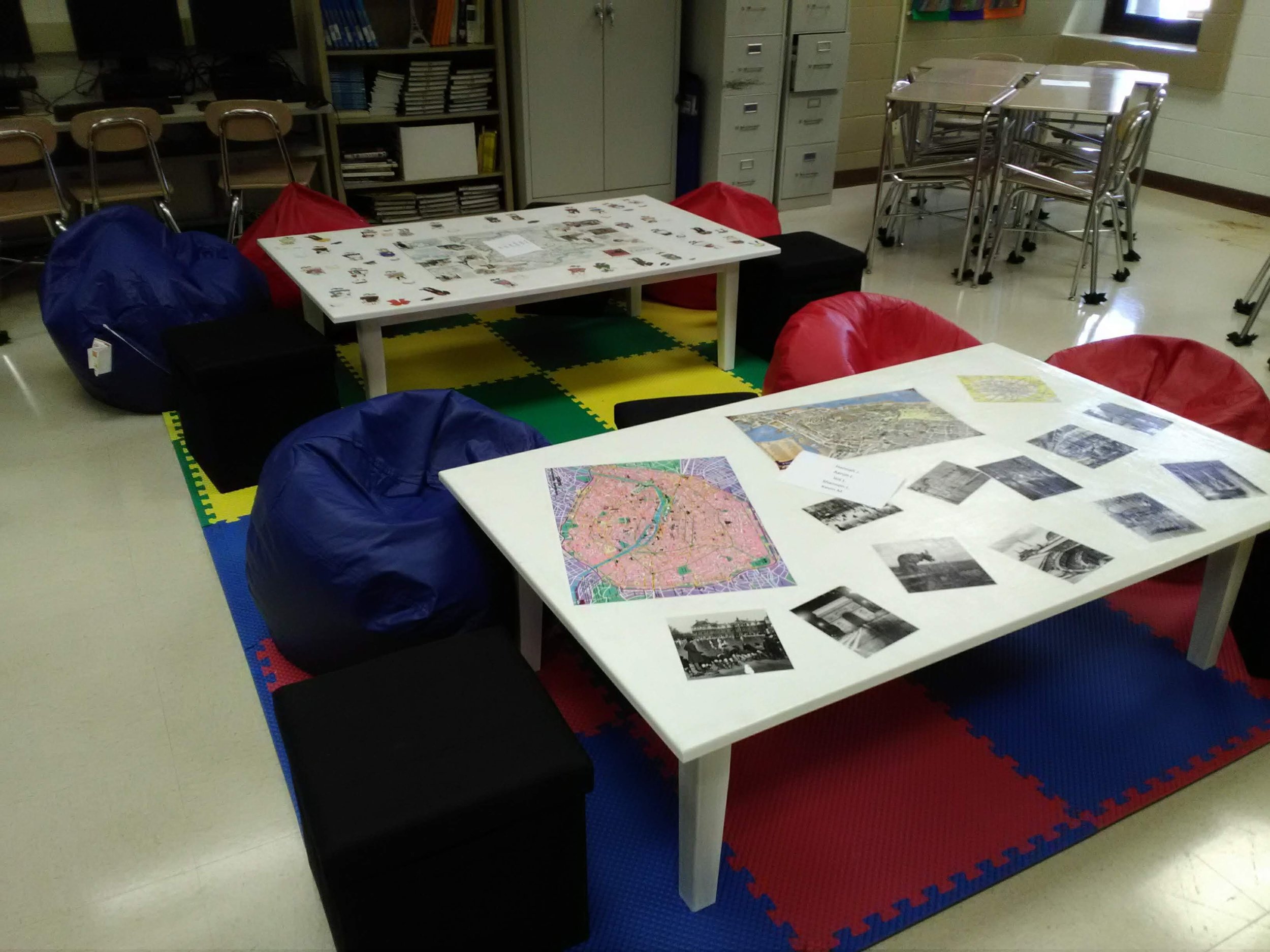Using Flexible Seating in High School
(or, why I hauled in the sofas… and then hauled them right back out again).
The headline caught my eye. “15 of the most beautiful classrooms in America”
“I want a beautiful classroom!” I thought as I began scrolling. Three hours later, I was drafting out plans for how I too could replace my boring, institutional desks with coffee tables, soft lighting, and overstuffed recliners.
Thus began my passionate, but ultimately ill-fated experiment with flexible seating in my High School French classroom.
I was somewhat on the cutting edge of the flexible seating trend. I like to innovate and am blessed with an administration (and a family) that puts up with my intense obsession with improving my classroom practice. I read everything I could find about flexible seating in advance of my own classroom launch. Of course, finding funding for the non-traditional furniture is a key hurdle (and could be its own blog post!). I was more interested, however, in the pedagogical evidence that non-traditional seating improved students’ perception of class along with their academic performance.
Advocates of flexible seating cite many benefits:
Flexible seating feels less harsh and more comfortable and inviting.
It allows students to have voice and choice in their learning space.
It mirrors adult work habits, where we may choose to sit on our bed, a sofa, at a desk, or at a coffee shop to work.
It increases student engagement.
Flexible seating encourages collaboration and creativity.
It can help students with learning differences such as ADHD.
“I want a beautiful classroom!” I thought as I began scrolling. Three hours later, I was drafting out plans for how I too could replace my boring, institutional desks with coffee tables, soft lighting, and overstuffed recliners.”
It incorporates more physical movement into the classroom. This has a TON of pedagogical benefits which I’ve written about here: movement increases blood flow and oxygen to the brain and reduces off-task behaviors and helps with emotional regulation. This, to me, was one of the most compelling reasons to introduce flexible seating.
So, in the summer of 2016 I made the leap. Thanks to garage sales, donations, thrift stores, my father-in-law’s carpentry skills, and a fair amount of muscle power (not to mention over $600 of my own money), I had a classroom to brag about.
Here it is:
Family and parents donated old sofas (and I found a few at the thrift store).
I kept some desks in case anyone felt like being wild and crazy (and traditional)
These low tables were my favorite feature of my new flexible seating. They were custom built by my father-in-law and decorated with French-themed images by me!
I don’t know if this would make the “15 most beautiful classrooms” list, but I was sure proud of it. One of my friends told me, “It looks like Starbucks… but really low end!”
So, how did it work?
First, the pros.
It made my classroom really inviting. The pictures speak for themselves. I was really happy with how my classroom looked.
My students loved it. They gasped audibly when they first entered the classroom. I heard students chattering excitedly in the hallways, “Have you seen our French classroom?!?” It was exciting to start class with this creative, out-of-the-box first impression.
Engagement – for some students. I do think some kids benefited from the non-traditional seating. It helped kids feel more comfortable and interested in coming to class.
It helped me stand out to my administrators as an innovative teacher who keeps up with educational research and trends. I was in my 40’s at this point, with 15 years of teaching under my belt, and it’s important to me to stay current. My flexible seating experiment definitely sent this message to my boss and colleagues.
I’m not sure if this is fair to count as a benefit, but they crossed my room off the list of standardized testing locations. So, along with the art and lab science teachers, I avoided the nuisance of rearranging my furniture for test administrations that school year.
Now the Cons.
This list is longer.
The room became very cluttered. It looks nice in the pictures, but add backpacks, chairs pulled out, and legs flopped in the walkways… it didn’t take long for the classroom to feel kind of chaotic. See for yourself:
Adding students made the flexible seating feel very crowded and chaotic.
2. Safety hazards. Related to the above, it was difficult to move around the classroom, for both me and for the students. Additionally, some kids were inclined to roughhouse in this more relaxed environment. At one point a girl hopped, knees first, onto a sofa… and landed on the pointy end of a pencil. Ouch!
3. Cleanliness. The mats and beanbags on the floors collected a lot of dust and grime. There was no good way to clean the soft furniture.
“It’s like feeding your kids vegetables every meal and then suddenly their grandma gives them a Mountain Dew and an ice cream sundae. There’s going to be a sugar high, followed by an emotional crash and possibly tears.”
4. It took longer to teach routines… a LOT longer. This is probably true in elementary school as well, but in an elementary classroom the teacher can deeply invest with one group of students to establish routines and systems that are used through the majority of their school day. In secondary, I was teaching and reteaching brand new procedures that were radically different from the students’ other classes. This was a lot to overcome and it took a lot of time. I also had to introduce new routines for who sits where and when and address conflicts over seating choices. This took up precious instructional time (and was at times exasperating).
5. It was easier for kids to hide nefarious behaviors. I had significant upticks in phone use and cheating during my flexible seating experiment.
6. The cost and logistics. Again, this could merit its own blog post. I was pretty creative in finding inexpensive seating and donations, and I don’t mind putting in some of my own money. But the school furniture is free (at least, the desks are!) I also had to figure out storage for all my classroom desks and arrange to have the furniture moved. It was pretty consuming.
7. Ultimately, it hurt student achievement in my classroom. After about 5 months, I noticed an interesting and increasingly clear trend: the more traditional a student’s seating choice, the higher their grade. I had 3 main types of seats in my room and I found that the kids who chose desks were earning A’s and B’s, kids who chose floor or beanbag seating with a table tended to earn B’s and C’s, and students who chose sofas were most likely to fail. This trend was consistent across my classes, different levels of French, and over time. It even applied to softer skills like handwriting; it was hard to decipher the sofa-sitters’ scrawl. Now, there’s probably some selection bias here; a student who chooses a traditional seat may be a more traditionally strong student. Even so, I couldn’t find much evidence that non-traditional seating helped my students learn better.
So, I backed in the pickup truck and hauled all the beanbags and sofas away.
Goodbye, flexible seating!
A few observations about my experiment.
I’m glad I tried it. My reasons for trying it were pedagogically sound, and my reasons for stopping were also based in good pedagogy. Ultimately, it’s about what’s best for students.
To anyone wanting to try flexible seating, I encourage you to look for forward-leaning seating options. I found seating that requires a student to lean forward (like a chair or stool) seemed to elicit more attention that seating that has a student reclining or leaning back (like a bean bag or sofa).
Every classroom has a culture. In a secondary setting, if kids are sitting in desks all day in most of their classes, and then they walk into a flexible seating classroom, it’s just a lot to adjust to. It’s like feeding your kids vegetables every meal and then suddenly their grandma gives them a Mountain Dew and an ice cream sundae. There’s going to be a sugar high, followed by an emotional crash and possibly tears.
Here’s a picture of my classroom today.
Notice the lack of beanbags.
I still use a lot of elements of flexible seating in my instruction: I change furniture positioning to facilitate different activities, and there is a lot of physical movement in my classroom. (Read more here). But, the classroom has a more traditional and structured feel. I’m OK with that. At the end of the day, we’re here to learn – and learning is not always comfortable!
Have you tried flexible seating in a secondary classroom? Share in the comments!






